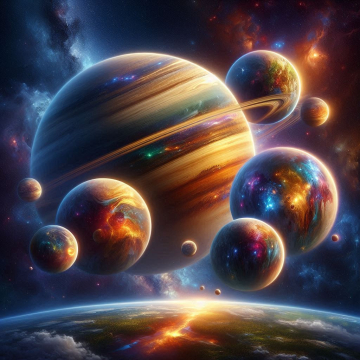Lunar eclipses are fascinating celestial phenomena that have amazed humanity throughout history. These magical events occur when the Earth comes between the Sun and the Moon, casting a shadow on our natural satellite.
What is a Lunar Eclipse?
A lunar eclipse is an astronomical event that occurs when the Earth, in its orbit around the Sun, aligns in such a way that it blocks the sunlight that normally illuminates the Moon. This alignment creates a shadow that gradually covers the Moon, plunging it into total or partial darkness, depending on an observer's location on Earth. There are two main types of lunar eclipses:
Total Lunar Eclipse: In a total lunar eclipse, the Moon is completely immersed in the Earth's shadow. During this phase, the Moon can take on a reddish hue due to the scattering of light through the Earth's atmosphere. This effect is known as a "Blood Moon" and is one of the most impressive aspects of total lunar eclipses.
Penumbral Lunar Eclipse: A penumbral lunar eclipse occurs when the Moon passes through the Earth's penumbra, a region of fainter shadow. During this type of eclipse, the Moon darkens slightly, but does not completely plunge into Earth's shadow. Penumbral eclipses are more subtle and often go unnoticed by most observers.
Mechanics of a Lunar Eclipse
For a lunar eclipse to occur, a nearly perfect alignment of three celestial bodies is required: the Sun, Earth, and Moon. The Moon, in its orbit around the Earth, crosses the Earth's orbital plane at least twice a year, forming two points called "nodes." When the Moon is close to one of these nodes and the Earth is between the Moon and the Sun, the conditions are created for a lunar eclipse. When the Moon enters Earth's shadow, it goes through three distinct phases during a total lunar eclipse:
- Penumbra Phase: In this initial phase, the Moon begins to enter the Earth's penumbra. The penumbra is a region of fainter shadow surrounding Earth's main shadow, called the umbra. At this stage, the Moon slowly begins to darken.
- Partial Phase: As the Moon continues to move into the Earth's shadow, it enters the umbra. In the partial phase, a portion of the Moon is in total shadow, while the rest is still illuminated by sunlight. During this stage, the Moon can take on a dramatically bifurcated appearance.
- Total Phase : Finally, the Moon moves completely into the Earth's umbra, and it is during this phase that we experience a total lunar eclipse. During this stage, the Moon can acquire a reddish color due to the scattering of light through the Earth's atmosphere. This effect is due to the same reason that sunsets and sunrises are often red.
It is important to note that lunar eclipses are safe events to observe with the naked eye, without the need for eye protection. Unlike solar eclipses, which can be dangerous to watch without proper precautions, lunar eclipses are completely safe to watch.
Mystery and Beauty of Lunar Eclipses
Lunar eclipses have been a source of mystery and wonder throughout human history. In many cultures, symbolic and mythological meanings were attributed to them. For example, the ancient Mayans believed that a celestial jaguar devoured the Moon during a lunar eclipse and therefore performed rituals to ensure that the Moon returned.
In other cultures, lunar eclipses were seen as bad omen events, portending disasters and conflict. However, with the advancement of science and understanding of the mechanics behind eclipses, humanity has come to appreciate the beauty and majesty of these celestial events.
One of the most impressive features of a total lunar eclipse is the reddish color that the Moon takes on when it is completely immersed in the Earth's shadow. This phenomenon is due to the scattering of light through the Earth's atmosphere. The atmosphere acts as a filter, allowing red colors to penetrate and reach the Moon, while blue and green colors are dispersed. This creates the iconic "Blood Moon" that we often see during a total lunar eclipse.
In addition to their visual beauty, lunar eclipses also have significant scientific value. Astronomers and scientists can take advantage of these events to study Earth's atmosphere, as light passing through our planet's atmosphere provides information about its composition and properties.
Observing a Lunar Eclipse
Watching a lunar eclipse is an exciting pastime for people of all ages. Here are some tips to make the most of this celestial event:
- Know the Time and Place: Find out when and where the next lunar eclipse will occur in your area. You can find this information online or through astronomy mobile apps.
- Use Binoculars or a Telescope: Although lunar eclipses are safe to observe with the naked eye, using binoculars or a telescope can offer a more detailed view of the lunar surface and its features.
- Find a Dark Place: To better appreciate a lunar eclipse, find a place away from light pollution, such as a park or rural area, where visibility is optimal.
- Bring a Chair and Warm Clothing: Lunar eclipses can last several hours, so it is advisable to bring a comfortable chair to sit in and warm clothing, especially if you plan to stay outside for a long time. Nights can be cold, even in the warmest seasons.
- Capture the Moment: If you are passionate about photography, lunar eclipses offer exciting opportunities to capture spectacular images. Make sure you have a camera capable of long exposures and a tripod to keep the camera stable while taking photos.
Lunar Eclipses in History
Throughout history, lunar eclipses have played a prominent role in mythology, religion, and science. Ancient cultures often attributed mystical meanings to these celestial events and incorporated them into their cultural narratives.
In ancient China, for example, lunar eclipses were believed to be caused by a celestial dragon devouring the Moon. To prevent the dragon from causing harm, people beat drums and made noise during eclipses to scare away the beast. This belief was a reflection of how ancient cultures attempted to understand and control the world around them.
In Norse mythology, the Vikings believed that lunar eclipses were caused by two wolves, Sköll and Hati, who chased the Moon and the Sun. When they caught them, eclipses occurred. This mythological narrative reflects how ancient cultures attempted to make sense of natural phenomena through stories and myths.
In ancient Babylon, one of the earliest records of a lunar eclipse is found on a cuneiform tablet dating back to 673 BC. The Babylonians were expert astronomers and kept meticulous records of lunar eclipses, contributing significantly to the development of astronomy.
Scientific Meaning of Lunar Eclipses
Today, lunar eclipses have significant scientific value. Astronomers take advantage of these events to study Earth's atmosphere and other properties. One of the interesting phenomena that occurs during a total lunar eclipse is the scattering of light. Earth's atmosphere filters sunlight, allowing red colors to filter through and reach the Moon. This provides valuable information about atmospheric composition. Furthermore, lunar eclipses have played an important role in the history of science, especially in validating Copernicus's heliocentric theory, which postulated that the Earth and the other planets orbited the Sun. The observation of lunar eclipses allowed scientists to Astronomers determined that the Earth was intervening between the Sun and the Moon, thus confirming the heliocentric theory.
Related Phenomena: The Blue Moon and the Blood Moon
Lunar eclipses can be even more exciting when combined with other celestial phenomena. Two of these phenomena are the "Blue Moon" and the "Blood Moon." Although these terms sound mysterious, they actually have scientific explanations.
Blue Moon: A Blue Moon is not really blue. It refers to the second full Moon that occurs in the same calendar month. Normally, there is one full Moon per month, but occasionally, due to differences in the length of the months and the lunar orbit, there may be two full Moons in one month. This phenomenon is rare and has no relation to the color of the Moon.
Blood Moon: The Blood Moon is a term used to describe the reddish appearance of the Moon during a total lunar eclipse. This coloration is due to the dispersion of light through the Earth's atmosphere, which filters the blue and green colors and allows the red ones to reach the Moon.
Upcoming Lunar Eclipses
Lunar eclipses are exciting events that occur around the world, but their visibility can vary depending on geographic location. Some lunar eclipses are visible over much of Earth, while others can only be observed in specific regions.
Penumbral Lunar Eclipse: March 5, 2025
This is a penumbral eclipse that will be visible in much of North America, South America, Europe, Africa and Asia.
Penumbral Lunar Eclipse: August 28, 2026
Another penumbral eclipse visible in North America, South America, Europe, Africa and Asia.
Total Lunar Eclipse: March 16, 2027
This eclipse will be visible in North America, South America, Europe, Africa, Asia and Australia.
Total Lunar Eclipse: September 8, 2027
This eclipse will be visible in North America, South America, Europe, Africa, Asia and Australia.
Penumbral Lunar Eclipse: February 13, 2028
This is a penumbral eclipse that will be visible in North America, South America, Europe, Africa and Asia.
Penumbral Lunar Eclipse: August 7, 2028
Another penumbral eclipse that will be visible in North America, South America, Europe, Africa and Asia.
Total Lunar Eclipse: January 25, 2029
This eclipse will be visible in North America, South America, Europe, Africa, Asia and Australia.
Penumbral Lunar Eclipse: July 16, 2029
Another penumbral eclipse that will be visible in North America, South America, Europe, Africa, Asia and Australia.






